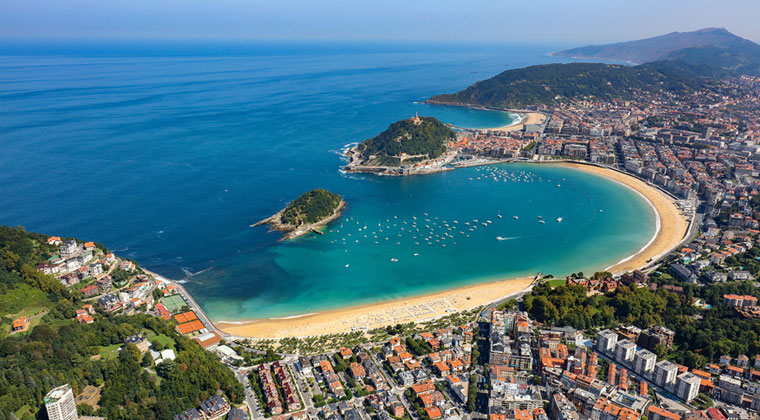DONOSTIA/SAN SEBASTIÁN, QUALITY OF LIFE
San Sebastian is a city located in the north of Spain, 20 km from the border with France.
The administrative capital of Guipuzcoa province, with 186,000 inhabitants, it is a small manageable city that is easy to get around, with various public transport options between the different points around the city.
The city has a sustainable mobility plan in place to promote public transport and non-motorised means of transport, the pedestrianisation of roads and the expansion of bike lanes.
San Sebastián currently has over 30km of cycle paths and bike lanes, and it is estimated that over half of all journeys within the city are made on foot or by bike. As a consequence, it is a fairly traffic free city.

Progress and cohesion

As well as having one of the highest per capita income levels in the country, San Sebastian has a highly educated population, where 34% of the population have a higher education, and 70% have their high school diploma (bachillerato).
With a good network of schools and quality commercial establishments, the city offers a high degree of progress and cohesion, with no major differences between its different neighbourhoods.
Economy

With average per capita income of34,600 euros, San Sebastian’s economy offers great potential, since its network of research centres, universities and companies provide a rich innovation ecosystem.
Furthermore, San Sebastian’s service industry represents 88.7 % of its economic activity, and it has consolidated businesses that offer quality employment in cutting-edge areas such as nanotechnology, ICTs, energy, ageing and health, machinery-tools, transport….
Quality of life and sustainability

The qualityof life enjoyed by the residents of San Sebastian is also thanks to the high levels of security in the city and its commitment to sustainability and the environment.
San Sebastian has a series of fixed stations to measure air quality, which have recorded that the number of days with good air quality is above 94%. The city also has a water distribution and sanitation network that meets the city’s needs in terms of quantity and quality. Furthermore,
San Sebastian has a huge number of green spaces, parks and gardens, as well as numerous children’s play areas that are easy to access and very beautiful.
Culture and recreation

San Sebastian is a cultural city, brimming with recreation and entertainment activities, and an excellent tourist destination.
It is visited by over 500,000 tourists a year, as the host of an International Film Festival, Jazz Festival, a Music Fortnight, theSurfilmFestibal and a Horror Film Festival.
It was also designated the European Capital of Culture in 2016. But its cultural offer goes beyond that: San Sebastian has an important network of cinemas, museums, libraries, and cultural venues.
Furthermore, thanks to its proximity to the sea, the mountains and the river, the sports possibilities offered by the city multiply the range of leisure options available: surf beaches, golf courses, race course, ice rink…
Gastronomy

San Sebastian also has more Michelin stars than any other city in the world. In fact, it is the only city in the world, together with Paris, with three restaurants that each have three stars, the highest accolade. As representatives of New Basque Cuisine, prestigious chefs such as Juan MaríaArzak, Pedro Subijana and Martín Berasategui, each with three Michelin stars, have restaurants in San Sebastian.
Furthermore, Mugaritz, which is 10 km from the centre of San Sebastian, is currently considered the fourth best restaurant in the world. ButSan Sebastian is also considered the world’s capital for ‘pinchos’: bars serving these miniature works of art are very popular in the Old Town. Additionally, San Sebastian has a pioneering academic institution in the world: the Basque Culinary Center, which focuses on advanced training, research, innovation, and the promotion of gastronomy and food.
Architecture

A 14th Century Gothic church, an 18th Century Baroque Basilica, buildings from the Belle Époque, palaces, rationalist buildings, contemporary works…
The architecture in San Sebastian combines tradition and vanguard. Its landscape, dominated by the Bay of La Concha, and its modern architectural development initiated in the second half of the19th Century, which shaped the city in the bourgeois style of France, fostered the development of global tourist activity.
Currently, owing to its numerous infrastructures, its accommodation and its strategic location, the city is the setting for a wide range of festivals, international congresses and conferences, which take place throughout the year.
